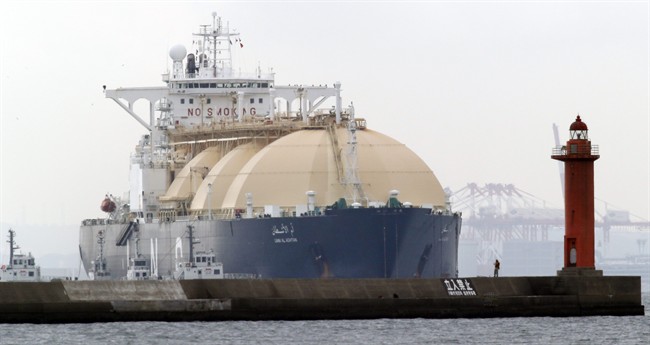VICTORIA – A major player in British Columbia’s liquefied natural gas sweepstakes has plans to spend up to $40 billion to build a proposed export facility on the province’s northern coast that could generate up to $39 billion in tax revenues over its lifespan.

The massive dollar figures were part of LNG Canada’s environmental certificate application released Friday by the joint venture company that includes Shell Canada Energy (TSX:SHC), PetroChina, Korea Gas Corp. and Mitsubishi Corp.
The B.C. government’s Environmental Assessment Office accepted the application, triggering a 180-day review phase, which includes public meetings in Kitimat, where the plant would be built, and in nearby Terrace.
“LNG Canada is proposing to spend between $25 billion and $40 billion on construction and between $7 billion and $17 billion per year during 25 years of operation, with decommissioning expected to cost between $2.1 billion and $3.3 billion,” the application stated. “The project will directly and indirectly create between 0.7 million and 1.4 million person-years of employment in Canada during construction, operation, and decommissioning, and generate between $17 billion and $39 billion in tax revenues for the government of Canada.”
LNG Canada said in a statement the acceptance of the environmental application was a major milestone that marks more than three years of environmental study, design work and consultation with local communities and aboriginal groups.
Earlier this week, the company signed the first LNG-driven agreement to connect up to Crown-owned BC Hydro’s power grid for up to 20 per cent of its energy needs.
The power contract, which includes a new energy and demand charge of $83.02 per megawatt hour before taxes, follows recent government announcements covering income tax rates and environmental emission standards for the LNG industry.
The average electrical power rate paid in 2014 by other industrial customers in the province is $54.34 per MWh.
The government’s tax, emission and power standards are geared towards providing investor certainty as companies decide on proceeding with multibillion-dollar projects. There are 18 potential projects at various development stages, but no company has made a final investment decision.
LNG Canada spokeswoman Susannah Pierce said in a conference call with reporters on Friday that B.C.’s tax, energy and environmental regulations continue to move LNG Canada’s project forward, but a final decision on proceeding has yet to be made.
“We’re still plugging ahead,” she said. “We were sufficiently happy with the tax and fiscal terms that came out recently. Certainly, with the hydro announcement and this announcement today, we are clearly moving forward.”
Pierce said finding qualified workers, reducing overall costs and being globally competitive continue to be major driving factors in proceeding with the project.
“In order to get past that goal post we’re really going to need to make the economic case here in Canada and it is challenging,” she said.
LNG Canada’s technical spokesman Wim Ravesloot said the costs estimates don’t factor in construction of the pipeline from northeast B.C. that will supply natural gas to the proposed Kitimat operation.
“At the moment we are building up our estimates, bottom up, taking into account the various components like the cost of construction, the cost of material, the cost of labour, and all these components add up to the total figure,” he said.
The environmental certificate application said the project will create 7,500 jobs at its peak construction phase. It states the project will generate about $94 million in municipal and regional taxes during construction and $15 million per year in municipal and regional taxes during operations.
Pierce said it would take five years to get the plant operating once a final investment decision was made.

Comments